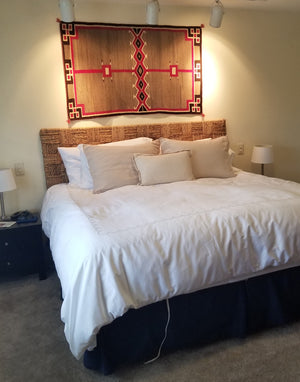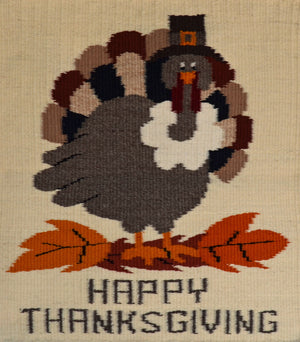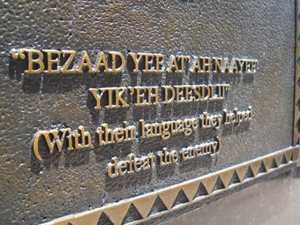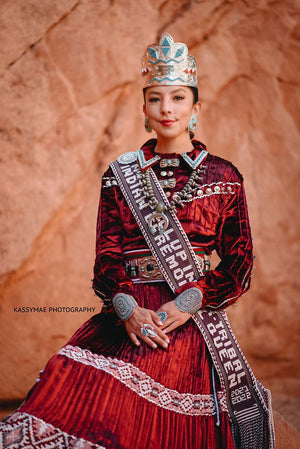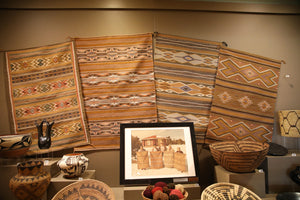Nizhoni Ranch News

Special Place in Arizona!
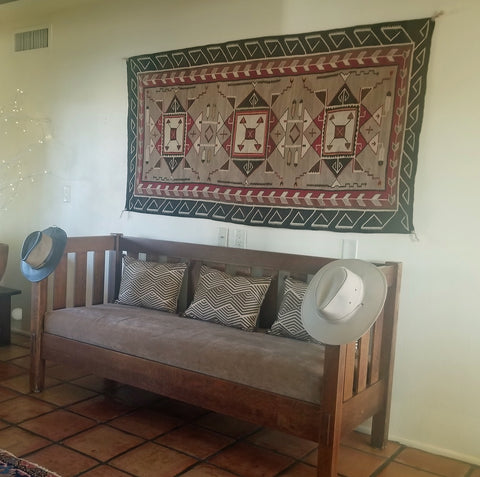
- Beth Barth

November 25th, Native American Heritage Day
The month of November is more than Thanksgiving. It's also Native American Heritage Month, a time designated to honor and recognize the contributions Indigenous people have made to the United States.
"Our resilience and our strength as the first peoples of this land should be celebrated every day," said IllumiNative founder Crystal Echo Hawk.
"As Indigenous peoples, we stand in our power every day. We continue to pass down traditions through ceremony, protect the wellness and health of our communities, and fight for clean air and water," she said.
Native American Heritage Month provides a national platform for Indigenous people to shed light on their communities by leading discussions about culture and tradition, educating the public about tribal communities or celebrating culture by wearing traditional footwear for a week.
"The month is a time to celebrate rich and diverse cultures, traditions, and histories and to acknowledge the important contributions of Native people," according to the National Congress of American Indians (NCAI).
"Heritage Month is also an opportune time to educate the general public about tribes, to raise a general awareness about the unique challenges Native people have faced both historically and in the present, and the ways in which tribal citizens have worked to conquer these challenges."
“Native American communities play a critical role in the growth and prosperity of our state,” Ducey said in a news release. “Arizona is enriched by the many diverse contributions from people all across our state, and this month, we are proud to celebrate the Native American community’s vibrant heritage, civic leadership, and history of service to our state and nation."
Arizona is home to 22 tribes, and tribal land makes up approximately 28% of the state’s land base, according to the governor's office.
- Beth Barth

Remembering the Navajo Veterans
All of us at Nizhoni Ranch Gallery would like to thank the Men and Women of the U.S.A. who served in the military and support services for our country, especially those of WWII. Many years ago this country came together in a valiant effort to help end an unbeatable war at great odds. In a state of great depression and poverty ourselves, the USA pulled together to go from the 8th military power in the world (behind Romania) to Number 1 !
Men, Women, Black, White, and Native Americans came together to work together to make this happen. The Navajo played a special part in this effort....
Seventy-five years ago, 29 young Navajo bi-lingual men joined the Marines and started boot camp. From there they went to Camp Pendleton in California and devised the Navajo Code - an undecipherable code by any one except those who spoke the language and knew the code.
These young pioneers, the Navajo Code Talkers, forged the path for a total of 421 young men. These WWII Warriors served at Guadalcanal, Peleliu, Tarawa, and Iwo Jima, and served as Code Talkers in assaults conducted by the US Marines in the Pacific from 1942 -1945. As of 1945, more than 500 Navajo had joined the Marines.
The Navajo Code continued to have value after the end of the war and remained classified. In 1992 the Code Talkers were honored at the Pentagon.
Today fewer than 10 of the code talkers survive. Two years ago it was estimated that 9,000 veterans live on the Navajo nation. Many Americans who live away from the Navajo area don't realize that the Navajo Nation encompasses 27,000 miles... the size of West Virginia.
Nizhoni Ranch Gallery helped Red Feather renovate then 94-year old Navajo Code Talker, Dan Akee's 4-bedroom home, so he could move back into it for his final days. Here is a short clip from Channel 12 News, before the project was finished....
The Red Feather organization partners with Hopi, Navajo, and Northern Cheyenne homeowners and community members to repair and winterize their homes by assembling volunteers, professionals, seeking grants, and donations. We applaud their efforts bringing the communities together to help themselves.
- Beth Barth

Booth Western Art Museum - Native Hands Exhibit!













- Beth Barth
- Stichworte: shows

Do You Know The Way to Santa Fe?
Celebrate Native art and culture at the largest and most prestigious intertribal art market in the world. Purchase jewelry, textiles, baskets, beadwork, carvings, sculptures, and drums directly from more than 1,000 of the “best of the best” Native artists, representing dozens of Tribes. And don’t miss the Indigenous fashion show, as well as the music, dance, storytelling, and comedy performances.
100th Annual Santa Fe Indian Market on the Plaza!
Free and Open to the Public!
No tickets necessary.
8:00 am - 5:00 pm
Free and Open to the Public!
No tickets necessary.
9:00 am - 4:00 pm

- Beth Barth

2nd Phase or 3rd Phase? Actually In-Between!
It is inspiring when Navajo rug collectors are born. Many immerse themselves so deep it is not long before they become experts. This collector is a perfect example of when the student becomes the teacher.
Please enjoy the following article!
May 1, 2022
Somewhere, Sometime, Somehow In-Between
by Ed B. from Minnetonka, MN
Somewhere, deep in a canyon or atop a high mesa, early Pueblo wearing blankets became the inspiration for the The First Phase Chief-Style blanket, or “beeldlei” in Navajo. This style was a simple broad striped weaving made of native hand-spun churro wool, wider than long and so tightly woven that it shed the rain. These blankets kept one safe by offering protection from the elements. Expensive to trade for, Navajo blankets became highly sought after as a sign of important social status and wealth. Hence the name Chief-Style Blanket.
Sometime in the 1840’s, The Second Phase of the Navajo Chief-Style Blanket began to evolve. The arrival of crimson colored cloth and yarns into the Navajo region and renewed experimentation with designs produced rectangular blocks and bands in the new colors. Positioned onto the simple broad striped pattern, this arrangement created the illusion of space by establishing a stable figure-ground relationship. When small shapes are placed upon larger shapes, the larger shapes are understood to be the background.
Somehow, by the 1860’s, the rectangular blocks and bands were slowly being replaced with triangular and diamond shapes that would define the Third Phase Chief-Style Blanket. Some shapes grew so large that they seemingly reversed the previous figure-ground relationship of the earlier Second Phase.
In-Between, there were early design ventures and continued experimentation with new shapes, colors and yarns that incorporated both the rectangular blocks typical of the Second Phase, combined with early stepped triangular shapes. Examples of this design combination are very rare.
In this early transitional or variant blanket, 1860-1870, stepped triangular shapes have just germinated, appearing to grow out of the straight bands of the Second Phase borders. Observe how these new shapes seem to burst into the broader striped areas. These triangular shapes help to create a newly defined border-contrast phenomena which is surely intensified by the triangular shapes when compared to the earlier straight bands. There exist only a few examples of this blanket design. Some refer to it as simply a Second Phase Variant or an early Third Phase.

- Beth Barth

Sandpainting : Father Sky Mother Earth
Sandpainting : Father Sky Mother Earth Navajo Weaving : Historic : JV 121 : 68" x 74" (5'8" x 6'2") : $18,000
Navajo Sandpainting - Father Sky, Mother Earth weaving from the Male Shooting Chant and used in various other chant ways.
The first creation of the Great Spirit was Father Sky and Mother Earth, from whence all life sprang.
The stars, sun, moon and the constellations are shown on the body of Father Sky. The zigzags crossing his shoulders, arms, and legs form the Milky Way. From the bosom of Mother Earth radiates the life-giving energy of the sun, bringing fertility to the womb of Mother Earth, from whence springs the seed of all living things. The 4 sacred plants shown are: Tobacco, Corn, Bean and Squash.
Mineral, vegetable, and animal – all things grow, mature, bear fruit, and fall. They all return back to the source from which they came (represented by the ovals at the bottom of Father Sky and Mother Earth).
The bat, the sacred messenger of the spirit of the night, and Big Fly or Sacred Fly guard the sand painting. The Rainbow Bars allow the Holy People to translocate instantaneously.
| Style | Sandpainting |
| Weaver | Unknown Navajo |
| Date | circa 1930s |
| Size | 68" x 74" (5'8" x 6'2") |
| Item # | JV 121 |
| Learn more about Sandpainting weavings | |
Contact us for more information at nizhoniranch@gmail.com or 520-455-5020.
- Beth Barth

President Roosevelt and Elle of Ganado
What do President's day and Navajo weavings have in common? A wonderful 2001 article published in "Frontiers: A Journal of Women Studies" brings both together in a way which helped shape the nation. Please grab a cup of tea, sit back and let your heart be filled.
Elle Meets the President: Weaving Navajo Culture and Commerce in the Southwestern Tourist Industry(1)
During the spring of 1903, President Theodore Roosevelt included a two-hour stop in Albuquerque while on a speaking tour through the western territories. the Commercial Club of Albuquerque chose a Navajo woman, called Elle of Ganado, to weave a gift for the president - a textile rendition of his honorary Commercial Club membership card. Club members provided the design, which Elle wove quickly in hand-spun red, white, and blue yarn.

During his tour of Albuquerque, Roosevelt visited the Commercial club, where he received Elle's blanket, and he stopped by the Alvarado Hotel's Indiana Building, where he met the weaver herself. An Albuquerque newspaper reported that upon meeting the weaver, the "president gave her a hearty shake and told her how much he appreciated her work. The little speech was interpreted and pleased the Indian woman beyond expression."
Although her own thoughts were apparently "beyond expression," Elle's image spoke volumes to turn-of-the-century Americans, showing New Mexico as not only conquered, but commercialized, safe for investment and safe for statehood.
Indeed, Commercial Club members orchestrated this performance as part of a statehood campaign, a drive for integration into the social, economic, and political life of the United States, an effort that would not pay off for nearly ten more years.
Elle and the president's meeting suggests ways in which race and gender, regional and national politics, culture and commerce interacted and were inextricably linked as the twentieth century began.
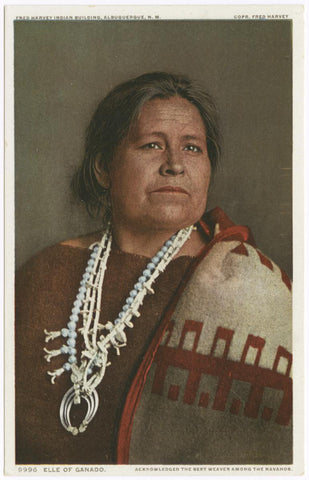 The pivotal role that Elle played in Roosevelt's visit reveals that while we tend to think of women like Elle as marginalized historical figures, they were far from peripheral to the unfolding of the twentieth-century American history. Not only can we better understand such women by placing them within the larger economic, cultural, and political context of their times, but we can better understand that context by putting a woman like Elle at its center. Elle of Ganado, also called Asdzaa Lichii' (Red Woman) in Navajo, was born to the Black Sheep Clan and lived in the southern part of the Navajo Reservation near the Hubbell Trading Post in Ganado, Arizona. She might have been about 50 years old at the time she met Roosevelt, and she lived until 1924. She was acknowledged as the best weaver among the Navajo.
The pivotal role that Elle played in Roosevelt's visit reveals that while we tend to think of women like Elle as marginalized historical figures, they were far from peripheral to the unfolding of the twentieth-century American history. Not only can we better understand such women by placing them within the larger economic, cultural, and political context of their times, but we can better understand that context by putting a woman like Elle at its center. Elle of Ganado, also called Asdzaa Lichii' (Red Woman) in Navajo, was born to the Black Sheep Clan and lived in the southern part of the Navajo Reservation near the Hubbell Trading Post in Ganado, Arizona. She might have been about 50 years old at the time she met Roosevelt, and she lived until 1924. She was acknowledged as the best weaver among the Navajo.
At the suggestion of trader John Lorenzo Hubbell, she and her husband Tom began spending substantial periods of time in Albuquerque beginning in 1903 after the Fred Harvey Company opened its Indian Building as part of the Alvarado Hotel complex at the Santa Fe Railroad depot. Together with other Navajo and Pueblo families, they worked as arts and crafts demonstrators within the burgeoning southwestern tourist industry.
You may read the rest of this fascinating article online here: https://www.jstor.org/stable/3347066
Navajopeople.org has an interesting piece about Elle's husband Tom here: http://navajopeople.org/blog/elle-ganado-wife-of-tom-ganado/
1Moore, Laura Jane. “Elle Meets the President: Weaving Navajo Culture and Commerce in the Southwestern Tourist Industry.” Frontiers: A Journal of Women Studies, vol. 22, no. 1, 2001, pp. 21–44., www.jstor.org/stable/3347066.
- Beth Barth










